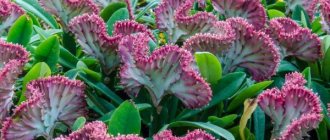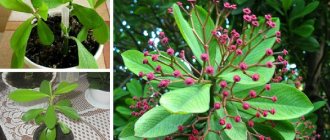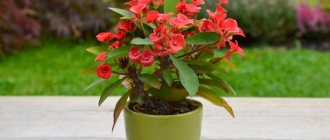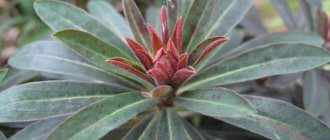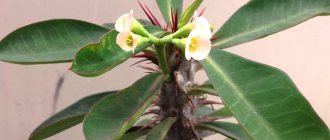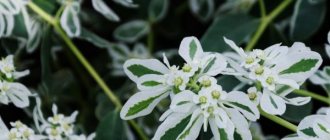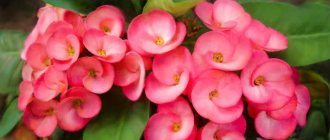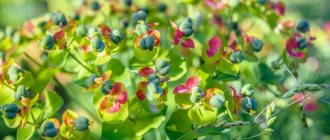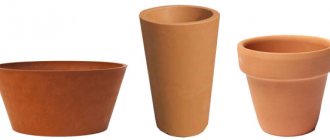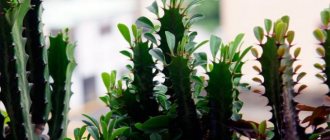Category: Traditional medicine, Succulents Published 10/23/2018 · Comments: · Reading time: 9 min · Views: 2,603
Euphorbia grass is a common perennial from the large family of Euphorbiaceae, which can harm garden crops, stifling their growth, and at the same time help the human body cope with a variety of ailments.
This amazing plant comes from Madagascar, but due to climate change, it has spread throughout the world. More than one and a half hundred species are found in Russia and the CIS, all of them have one thing in common - a poisonous milky sap that fills parts of the grass. This toxic liquid is successfully used in folk medicine, but be careful, as the juice contains poisons. What are the benefits of milkweed juice, how dangerous is it and how to use it correctly?
Types of milkweed
The herb spurge has 2000 varieties. There are about 170 items in the CIS countries. The plant is widespread in countries such as Belarus, Moldova, and Ukraine. The grass is found in the Caucasus and Central Asia. Euphorbia grows in the form of shrubs, perennial and annual grass, and small trees. What unites all its varieties is the presence of caustic juice in it.
What does spurge grass look like? The general appearance of plants is very diverse. Some stems are ordinary, without thorns, others are prickly, and others are fleshy and faceted. It has yellow lobed leaves. The plant releases its color in May; by July it grows and completely drowns out the nearby vegetation. The shape of the milkweed flower resembles a glass.
Description of milkweed with photo
The birthplace of culture is the African continent. Madagascar and Central America. The botanical name of the plant is euphorbia; it is the most basic and most numerous representative of the Euphorbiaceae family of the same name. It looks like grass, shrubs, and in rare cases, trees. The appearance of representatives of the genus can also be very diverse. With smooth, leafy or prickly shoots, cactus-shaped, columnar and others. A common property, like all euphorbias, is the presence of milky sap in all parts of the plant, which, like all members of the family, in its pure form is caustic and toxic. Herbaceous forms of milkweed can have either a one-year or perennial life cycle. The shoots are most often of an ascending type, up to strictly vertical, but there are creeping types (“jellyfish head”) and spherical ones, which do not give lateral branches at all.
The height of milkweed varieties varies within very significant limits, from a few centimeters in dwarf representatives to exceeding human height. During flowering, in the upper part of the shoots, the leaves turn into bright bracts, creating the impression of a smooth transition into a small but bright bouquet.
Euphorbia is a poisonous crop that is not recommended to be grown in areas where there may be accidental contact with children or pets.
Preparation and storage
To properly collect flowers, you need to make sure that the plant being harvested is milkweed. After all, if you collect the wrong herb, it will not have the desired effect, and otherwise poisoning or other negative consequences may occur.
When harvesting the herb, spurge should not be allowed to include other medicinal plants. It is better to collect in areas where large quantities grow.
Folk recipes use the root, stems and juice. All these parts should be prepared separately. The juice is obtained from the fresh plant. Then it is evaporated in a water bath and placed in glass containers. Store blanks only in a cool place.
Euphorbia roots are harvested in early spring. This is done before the first leaves appear. You can also harvest them in late autumn, when the plant begins to wither. The dug up roots are cleaned of dirt, washed, treated with boiling water and dried at a temperature of 40 degrees.
The stems and grass of milkweed are collected before it blooms. After harvesting, the juice is squeezed out and the plant is laid out to dry.
Euphorbia flowers are harvested on rare occasions and then placed in places where the sun's rays do not reach. The finished raw materials are placed in glass jars for storage.
The dried plant can be stored for no more than 1 year. After this period, its medicinal properties are lost.
Necessary features of milkweed
Euphorbia has been known in the distant past for its own healing properties. It is not too safe to use it yourself at home, since milkweed juice becomes medicinal only after special processing has been completed. The medicinal properties of milkweed were known even before our era. They actively treated various diseases, but only skilled healers knew the required concentration of the medicine. In addition, the poisonous qualities of milkweed have been used.
So, in agriculture, the juice of this plant is used to counteract bedbugs and caterpillars.
It is possible to use all parts of the plant; it is only important to process them correctly.
Euphorbia flowers are dried in the sun. The roots must be collected in spring or autumn, when the flower has faded. The roots are washed and dried in the oven, and then stored in a dry, black place. The leaves can be dried on the windowsill. Euphorbia juice can be collected both during flowering and outside of it.
Uses of milkweed
In the Euphorbiaceae family there is such a houseplant as croton. Croton oil is obtained from it, which was quite popular in the 19th century. It was often used in perfumery.
Another type of malaria is cassava. It produces roots that can be eaten. They can only be consumed boiled, because raw they are poisonous.
Many species of milkweed are dangerous to health, which is why they were used as weapons by the indigenous people of Africa and the Caribbean. If its juice got into the eyes, people could become completely blind within a few minutes.
The castor bean plant is a plant from the Euphorbiaceae family from which castor oil is produced. It is popular and can be used for hair growth.
Among many plant species there is the weed spurge, which causes great harm to gardeners. Its negative properties will be discussed later in the article.
Composition of milkweed juice
The milky white juice has a pungent taste, but is completely odorless. It is released from the cut of the plant and quickly hardens in the air.
The composition of milkweed juice includes: saponins, alkaloids, gum, tannins and other components.
Euphorbia is a natural aphrodisiac that increases the body's defenses. The juice of the plant has antiseptic and antibacterial properties.
Useful qualities
What are the medicinal properties of the herb spurge? Preparations based on the plant are actively used to heal wounds on the skin. They are used in the form of baths or tinctures to treat fungus and gout. Euphorbia juice works well on warts that are lubricated with it. A more common method is treatment using a decoction of the plant.
In folk medicine, euphorbia was used as a remedy with laxative, anthelmintic and diuretic properties. Currently, the range of its use has increased significantly.
Euphorbia slows down the growth of tumors, cleanses the blood and prevents the growth of metastases. The lactones contained in the herb have antitumor properties. Due to its healing qualities, euphorbia is used to treat various tumors. It is often used for sarcoma. The plant is effective during the period of restorative chemotherapy.
Euphorbia can be used internally to combat worms. A decoction of the plant is effective for anthrax, rabies and paralysis.
Women can use it to treat mastopathy, uterine fibroids and infertility.
Euphorbia is often used to treat anemia. It is used for serious development of tuberculosis, as well as for complex therapy of bronchitis, bronchial asthma and pneumonia.
Having bactericidal properties, spurge can relieve inflammation due to cystitis. For diarrhea, the decoction relieves symptoms due to the presence of tannins in the plant.
The root of the herb is used to treat headaches and treat problems of the male genital area. Euphorbia root extract is considered a powerful emetic. Therefore, it can be used for bites of rabid animals and acute intestinal diseases.
Currently, the properties of milkweed are also used in official medicine. Its infusions in low concentrations are used in the treatment of kidney diseases, hemorrhoids, eczema and skin fungus. The herb relieves inflammation and reduces pain.
People who are overweight can take a decoction of milkweed. The plant helps to increase the protective functions of the body. It is best used in the autumn-winter period to prevent colds.
Due to the poison contained in the plant, caution should be exercised when used externally.
Why it’s dangerous: possible harm
In addition to its benefits, euphorbia can also cause serious harm to the human body if you are not careful with this plant.
Skin burn
Euphorbia juice is caustic and poisonous, so it can have an aggressive effect on the skin, causing burns. The burn is accompanied by pain and profuse itchy rashes.
If you come into contact with milky juice, you should immediately rinse the area with plenty of clean water and then apply ice to the affected area.
Sometimes the skin reaction can be too severe and manifest as a severe allergic reaction. In such cases, in addition to rinsing, it is necessary to use antihistamines.
What to do if juice gets into your eyes?
Such an accident can be dangerous. In such a situation, you need to rinse the affected eye as soon as possible with plenty of running water or chamomile decoction, and then immediately seek help from a doctor. Be sure to show your doctor a sample of the plant that caused the burn.
If the milky juice of milkweed gets into your eyes, you should never self-medicate. You should immediately seek help from doctors, since delay can even lead to complete blindness.
Intoxication due to poisoning
Such poisoning can occur when toxic compounds penetrate into the body. This can happen under the following circumstances:
- When caring for a home flower. Most indoor varieties of milkweed contain poisonous sap in their tissues. When carrying out any manipulations with the plant, you must use protective gloves, and wash your hands with soap after the procedures.
- Preparation of healing potions. Do not exceed the dosages recommended in the recipe when making homemade decoctions or tinctures based on the plant.
- Allowing small children to visit the plant. Playing with parts of a poisonous plant is always a bad idea, so if there are small children in the house, you need to isolate them or the flower.
After a person drinks concentrated milkweed juice (or eats the plant) within 6-12 hours, signs of intoxication will appear:
- severe dizziness;
- headache;
- nausea;
- burning in the throat and esophagus;
- sharp pain and colic in the abdominal area;
- vomit;
- diarrhea;
- dehydration of the body.
After the absorption of toxic compounds into the blood occurs, the patient will feel an increase in body temperature, his consciousness will begin to become confused, convulsions and loss of orientation in space will appear. Without proper care, the patient will fall into a coma.
Folk recipes from milkweed
The medicinal properties of milkweed have found their application in the treatment of the following diseases:
- Tincture for the treatment of fungus, eczema and lichen. 1 teaspoon of herb is poured into 500 ml of boiling water. Let it sit for half an hour and strain. The product should be used as baths. To treat lichen, use the juice of a fresh plant, which is applied to the sore spot. Leave for 20 minutes and rinse thoroughly with water.
- Gastrointestinal diseases. 5 grams of root are poured into 1/2 liter of water. Boil the liquid for 10 minutes. Take the product 3 times a day, a tablespoon a quarter of an hour before meals.
- Getting rid of freckles or age spots. Apply the juice of the plant to your face and wash it thoroughly after 10-15 minutes.
- Treatment of calluses. This recipe has been known since ancient times. Apply the grass juice to the calluses and put on socks. The procedure is carried out at night, for 6-7 days. In the morning, wash off the juice and apply pumice.
- Depilation. To facilitate the process, add a teaspoon of plant juice to 100 grams of boiled water. Wipe the area where depilation is planned. The procedure will go faster, and the hairs will grow slower.
By using the herb euphorbia in the treatment of diseases, you can quickly reduce their symptoms.
Euphorbia garden
What does the herb Euphorbia look like? Gardeners begin to fight this weed in early spring. The herb is a plant with spiny leaves, a hard stem and a white milky secretion. Its root system goes deep into the soil, and its depth can reach 1 m.
Experienced gardeners remove spurge weeds only with a shovel. Constant deep weeding, digging up the soil in spring and autumn, and the use of herbicides are the main methods of combating it.
Enormous harm is caused to grain crops, which cannot develop normally due to milkweed. It also interferes with plants that are grown in the garden. Possessing a developed root system, malochea sucks out all the beneficial substances from the soil. This causes the death of other plants.
Despite its harmful qualities, the plant is a good soil indicator.
Euphorbia care
Growing in open ground does not require much trouble; the plant will be content with infrequent watering, even more infrequent feeding and timely weeding.
- Faded shoots must be removed as soon as possible to avoid self-seeding and loss of decorativeness of the flowerbed.
- It is necessary to water spurge not only moderately, but even sparingly, occasionally wetting the top layer of soil. With regular precipitation, this measure is not required.
- For feeding, universal mineral complexes for flowering plants are used.
- It is necessary to ensure that fertilizers applied during flowering contain a minimal amount of the nitrogen component or do not contain it at all.
Ways to combat milkweed
Euphorbia is a weed, so there are several methods for controlling it. They use traditional methods or modern drugs. Sometimes both methods are used.
It is best to start fighting the weed in early spring, when the leaves are just appearing on the plant. It is imperative to pull out the grass by the roots, without leaving even a single particle of it in the ground. If this is not done, the spurge will germinate in the soil again.
When fighting a plant, it is completely pulled out along with the roots.
The second method used to control field spurge grass is the use of herbicides. By combining these two methods together, you can completely get rid of weeds in your garden.
Description
There are many types and varieties of milkweeds. Some of them look decorative and are specially grown to decorate the site. Euphorbia is one of the worst weeds that needs to be controlled. But for the fight to be effective and give a positive result, you need to know who the enemy is.
The weed Euphorbia grows up to several meters. It has a thick, fleshy stem and large leaves with sharp spines. The leaf shape is a triangle. The stems and leaves contain a large amount of juice. An adult weed occupies an area with a diameter of 40 cm.
The root system is branched, powerful, the roots firmly hold onto the soil. The central root goes to great depth. Therefore, the plant is not afraid of drought: the roots can always get water. Euphorbia weed you see in the photo. There are few brave souls who can pull out a thorn with their bare hands.
In hot weather, the plant droops due to lack of moisture, thereby reducing the area of evaporation. Under favorable conditions, it can quickly fill large spaces. Moreover, it grows successfully in any soil. You can even find this plant in swamps and rocks.
It is propagated by seeds that ripen in large quantities and by lateral shoots growing from the lateral roots. Therefore, getting rid of milkweed weed is not so easy. Also, when you simply cut a plant without removing the root, it will produce new shoots. In place of one plant, a whole bush of weeds grows.
Flowering of the garden weed begins in July and continues until August. The flowers are monoecious, with a calyx around them resembling a spathe. The inflorescence contains one female and ten male flowers. The plant has an interesting trinut fruit with three lobes.
Attention! The most terrible enemy of gardeners is spurge vine.
This plant has small leaves with a thick waxy coating. To help you identify the weed, we attach a photo.
Some rural residents feed this weed to their pets. In its raw form it is very dangerous. If it is caught in the hay, then there is nothing to worry about, since the juice dries up.
Properties of common milkweed
Euphorbia contains sap in its stem, which is very poisonous to animals. It has many beneficial properties for human treatment. It can be used effectively in the treatment of childhood skin diseases.
The herb Euphorbia has a laxative and anthelmintic. For internal use, a decoction of the plant is prepared. Pour 2 tablespoons of the plant into a liter of hot water. Boil for 10 minutes and leave throughout the day. Drink 200 ml on an empty stomach in the morning.
Sometimes the plant is used to treat hemorrhoids and intestinal colitis. You can drink the infusion to improve metabolism.
Prevention
Killing the spurge weed using various means is half the battle. The main thing is to consolidate the result. Mulching the soil using organic or inorganic means will help with this.
The dug up and processed area is covered with a thick layer of sawdust, wood chips, shavings, and humus. Covering with roofing felt or dark film (spunbond) helps a lot. The temperature under the shelter is high, the roots of the plant die, and the sprouts cannot break out.
Horse chestnut: medicinal properties and contraindications
No weeds, no chemicals:
Contraindications to the use of milkweed
When using milkweed, we must not forget that the plant is poisonous. All products from it must be prepared with strict adherence to dosages and rules of administration.
Treatment with milkweed should be carried out under the supervision of an experienced specialist. After all, he can suggest the correct and safe regimen. With prolonged use of the plant, side effects may occur. The finished product should not get into the eyes or face; if this happens, the medicine must be washed off with water.
Main contraindications:
- individual intolerance;
- pregnancy and lactation;
- allergic reactions on the skin.
All milkweed products are contraindicated for children. Prolonged contact may cause a burn on the skin, so the affected area should be washed with water and a cold compress applied. Be sure to give your child an antihistamine.
First aid for poisoning
Algorithm of action in case of poisoning:
- Call an ambulance.
- Drink 3 liters of cold water and induce vomiting.
- Take activated carbon or Enterosgel.
- Try to lie down and wait for the doctor.
If a person feels itchy skin or has a swollen tongue, take Suprastin or another antihistamine.

